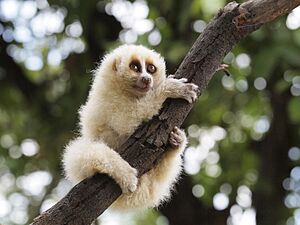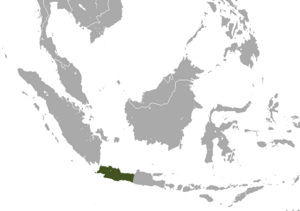Javan slow loris facts for kids
Quick facts for kids Javan slow loris |
|
|---|---|
 |
|
| Conservation status | |
| Scientific classification | |
| Genus: |
Nycticebus
|
| Species: |
javanicus
|
 |
|
| Range of the Javan slow loris | |
| Synonyms | |
|
|
The Javan slow loris (Nycticebus javanicus) is a small, furry primate that lives in trees. It's a type of slow loris found only on the island of Java in Indonesia. For many years, people thought it was just a type of Sunda slow loris. But after looking closely at its body and DNA, scientists realized it was its own unique species.
This loris has a special white diamond pattern on its forehead. This pattern is made by a stripe that goes over its head and splits towards its eyes and ears. Javan slow lorises usually weigh between 565 and 687 grams (about 1.2 to 1.5 pounds). Their body, not including the tail, is about 293 millimeters (11.5 inches) long.
Like all lorises, it lives in trees and moves slowly. It walks carefully along vines and branches instead of jumping. You can find them in different types of forests, like bamboo and mangrove forests. They also live on chocolate farms! Their diet includes fruit, tree gum, lizards, and eggs. They often sleep on open branches, sometimes in small groups.
Sadly, the Javan slow loris is in great danger. Its population is shrinking fast. This is mainly because people catch them to sell as exotic pets. Sometimes, they are also used in traditional beliefs. Losing their habitat (where they live) is another big problem. Because of these threats, the International Union for Conservation of Nature (IUCN) says it is "critically endangered." This means it's very close to disappearing forever.
Contents
Discovering the Javan Slow Loris
The Javan slow loris was first described by a French scientist named Étienne Geoffroy Saint-Hilaire in 1812. The name javanicus simply means "from Java." For a while, scientists thought it was just a type of another slow loris.
In 1921, another slow loris from Java was named Nycticebus ornatus. Later, in 1971, a scientist named Colin Groves said the Javan slow loris was just a subspecies of the Sunda slow loris. This meant he thought it was a different kind of the same species.
But in the 2000s, scientists looked more closely. They studied its skull and fur. They also checked its DNA. These studies showed that the Javan slow loris is indeed its own separate species. It is most closely related to the Bengal slow loris and the Sunda slow loris.
There are two main types of Javan slow lorises. They are mostly different because of how long their fur is. One type has longer fur than the other.
What Does a Javan Slow Loris Look Like?
The Javan slow loris weighs between 565 and 687 grams (about 1.2 to 1.5 pounds). It looks a lot like the larger Bengal slow loris. Its face and back have a clear stripe. This stripe goes over the top of its head and then splits towards its eyes and ears. This creates a white diamond shape on its forehead.
Its fur is usually yellowish-gray. But its head, neck, and shoulders can have creamy colors. Like some other slow lorises, it is missing one of its front teeth.
The Javan slow loris is bigger than the other slow lorises found in Indonesia. These are the Sunda slow loris and the Bornean slow loris. The ornatus type of Javan slow loris has longer fur. Its fur averages about 26.8 millimeters (1.05 inches) long. The other type, javanicus, has slightly shorter fur, about 22.4 millimeters (0.88 inches) long. The ornatus type is also generally lighter brown.
Life and Habits
Like all lorises, the Javan slow loris is nocturnal. This means it is active at night. It also lives in trees, moving slowly along vines and branches. Sometimes, if it needs to cross an open area, it might move on the ground.
These lorises usually move through the tree tops at heights between 3 and 22 meters (10 to 72 feet). But they are often seen closer to the ground, between 1.5 and 9.5 meters (5 to 31 feet) high.
The Javan slow loris eats a variety of foods. Its diet includes fruits, lizards, and eggs. It also likes to eat the sticky gum that comes from certain trees. These trees include Albizia and Arenga palms.
Javan slow lorises are usually seen alone or in pairs. Sometimes, they are found sleeping in small groups. They don't build nests. Instead, they sleep curled up on tree branches. Like other slow lorises, they make a special high-pitched whistle sound.
Where They Live
The Javan slow loris is found only in the western and central parts of the island of Java in Indonesia. They live in places like the Dieng Mountains. They are also found in Gunung Gede Pangrango National Park and Mount Halimun Salak National Park. In these parks, they are usually found in areas where people don't disturb them much.
They live in both untouched forests and forests that have been disturbed by humans. You can find them from sea level up to 1,600 meters (5,200 feet) high. They are more common at higher elevations because lower areas often have fewer trees.
Studies have shown that Javan slow lorises can live in bamboo forests and mangrove forests. They also live on farms, especially chocolate plantations. In 2008, they were even seen living in mixed-crop gardens in West Java. This shows they can handle some human activity around them.
Protecting the Javan Slow Loris
The International Union for Conservation of Nature (IUCN) lists the Javan slow loris as "critically endangered." This is because its population has dropped very quickly. In the last 21 to 24 years, their numbers have fallen by at least half. There aren't many of them left, with only about 0.02 to 0.20 individuals per square kilometer.
Their numbers are still going down, mainly because of poaching. Poaching means illegally hunting or catching animals. In Indonesia, some people use them in traditional beliefs. But most often, they are caught to be sold as exotic pets. It's easy to catch them because they move slowly, are active at night, and sleep on open branches.
Their homes are also disappearing. Most of the forest loss happened by the mid-1980s. The areas where they live are heavily used by people. This means the Javan slow loris is more threatened by losing its home than other slow loris species. Because of these serious threats, the Javan slow loris is on "The World's 25 Most Endangered Primates" list.
To help protect them, the Javan slow loris was moved to CITES Appendix I in 2007. This gives them more protection from being traded illegally. They are also protected by Indonesian law. However, these laws are not always strongly enforced where the lorises live.
The Javan slow loris can be found in several protected areas. But their exact numbers in these areas are not known. Some Javan slow lorises live in zoos and rescue centers. You can find them in Prague, Czech Republic, Jakarta, Indonesia, and Singapore.
Conservationists working for the Little Fireface Project on Java have built special walkways high in the trees. These walkways help Javan slow lorises move safely between trees in areas where forests have been cleared for farming. These walkways also help local farmers by acting as irrigation pipes. In return, the farmers help take care of the walkways.




